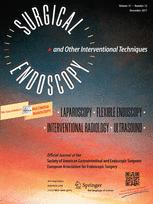Testoni PA, Vailati C, Testoni S, Corsetti M
Surg Endosc. 2012 May; 26(5):1425-35.
INTRODUCTION:
Transoral incisionless fundoplication (TIF) with the EsophyX(™) device is reported to be effective for creating a continent gastroesophageal valve and for good functional results, as measured by pH impedance in patients with gastroesophageal reflux disease (GERD). The aim of this study is to assess the long-term effect of TIF in patients with symptomatic GERD.
PATIENTS AND METHODS:
TIF 2.0 fundoplication was done in 42 consecutive patients. All were studied with GERD-HRQL and GERD-QUAL questionnaires, upper gastrointestinal (GI) endoscopy, esophageal manometry, and 24 h pH impedance before and at 6, 12, and 24 months after TIF.
RESULTS:
In all, 35 patients completed 6-month follow-up; 21 (60.0%) completely stopped proton pump inhibitor (PPI) therapy, 6 (17.1%) more than halved it, and 8 (22.9%) continued with the same dose as before the procedure. There were 26 patients with complete 24-month follow-up; 11 (42.3%) completely stopped PPI therapy, 7 (26.9%) more than halved it, and 8 (30.8%) were taking the same dose as before the procedure. Hiatal hernia and ineffective esophageal motility seemed to raise the risk of recurrence of symptoms (p = 0.02 and p < 0.001, respectively). The number of fasteners deployed during TIF was the only factor predictive of successful outcome (p = 0.018).
CONCLUSIONS:
TIF using the EsophyX device allowed withdrawal or reduction of PPI in about 77% of patients at 6-month follow-up and about 69% at 24 months. Larger number of fasteners deployed during TIF was predictive of positive outcome; pre-TIF ineffective esophageal motility and hiatal hernia raised the risk of recurrence of GERD symptoms, but were not significant from a prospective point of view.
Link to abstract on PubMed: Testoni PA, et al; Surg Endosc. 2012 May; 26(5):1425-35.


